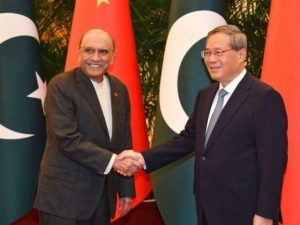Pakistan President Asif Ali Zardari’s five-day state visit to China, beginning on February 4, underscores the deepening yet fraught dynamics of the relationship. While the visit is framed around reinforcing economic collaboration and security under the China-Pakistan Economic Corridor (CPEC), it occurs against a backdrop of escalating debt stress, stalled infrastructure projects, and persistent threats to Chinese nationals in Pakistan. This moment demands a clear-eyed assessment of whether the partnership can evolve beyond its current transactional inertia to address structural challenges.
Pakistan’s economic reliance on China has reached precarious levels. According to AidData, Pakistan’s external debt to China stood at $68.91 billion as of November 2023, accounting for 22 percent of its total external debt. With total public debt at 74.3 percent of GDP, Islamabad’s fiscal sovereignty is increasingly mortgaged to Beijing. Recent negotiations to reprofile $16 billion in energy sector debt and extend a $4 billion cash loan facility highlight Pakistan’s desperate balancing act: sustaining Chinese investments while avoiding default.
CPEC, once hailed as a game-changer, now exemplifies these contradictions. Launched in 2015, the corridor’s first phase focused on energy and infrastructure. However, delayed projects, cost overruns, and allegations of opaque contracts have eroded its viability. For instance, Pakistan owes $7.5 billion in project debt to CPEC-linked power plants and $2 billion in unpaid bills to Chinese energy firms. As economist Ali Hasanain noted, CPEC’s “original sin” was its reliance on foreign-currency obligations that clash with Pakistan’s domestic fiscal policies, narrowing Islamabad’s economic maneuvering space.
The second phase of CPEC, announced in 2023 with proposals for growth, innovation, and green energy corridors, remains aspirational. Over a year after the vision was announced, Pakistan has only begun drafting concept papers – a far cry from the rapid mobilization seen in CPEC’s early years. This inertia reflects Beijing’s shifting priorities: safeguarding existing investments rather than expanding commitments.
Security concerns have emerged as the Achilles’ heel of bilateral ties. Since 2021, 14 terrorist attacks targeting Chinese nationals have killed 20 and injured 34, per Pakistan’s National Counter Terrorism Authority. High-profile incidents, such as the March 2024 Shangla suicide bombing that killed five Chinese engineers and the October 2024 Karachi airport attack, have strained diplomatic patience. Groups like the Balochistan Liberation Army (BLA) and Tehreek-e-Taliban Pakistan (TTP) exploit local grievances over resource exploitation and marginalization to justify targeting CPEC projects.
China’s response has been uncharacteristically blunt. In November 2024, Ambassador Jiang Zaidong publicly admonished Pakistan’s Foreign Minister Ishaq Dar, stating, “It is unacceptable for us to be attacked twice in only six months.” Such candor signals Beijing’s frustration with Islamabad’s inability to secure projects despite a 12,000-strong security force dedicated to CPEC. Reports of China seeking to deploy private security firms or joint mechanisms further underscore this distrust.
Pakistan’s proposed solutions – such as a state-backed security firm staffed by retired military personnel – appear reactive. Without addressing root causes like Baloch alienation or the TTP’s cross-border havens, temporary fixes might fail to reassure Beijing.
Zardari’s visit follows Prime Minister Shehbaz Sharif’s June 2024 trip, where both sides pledged to “forge an upgraded version” of CPEC. However, the gap between rhetoric and reality is widening. While Sharif’s Shenzhen and Xi’an tours emphasised a desire for technology and agriculture transfers, tangible outcomes remain sparse. Similarly, the virtual inauguration of Gwadar’s CPEC-built airport during Chinese Premier Li Qiang’s October 2024 visit – a decision driven by security fears – symbolizes the increasing strain in the relationship.
China’s calculus is clear: It seeks to protect existing assets rather than pour funds into high-risk ventures. This explains its focus on commercial viability and reluctance to endorse CPEC’s second phase without guarantees. Meanwhile, Pakistan’s attempts to diversify partnerships, such as courting Saudi investments or engaging the United States on counterterrorism, risk alienating Beijing.
The China-Pakistan relationship stands at an inflection point. For Islamabad, Zardari’s visit is an opportunity to negotiate debt relief and reassure Beijing of its commitment to security. For China, the fact that U.S. President Donald Trump has temporarily suspended U.S. assistance to foreign countries, including Pakistan, gives it an opportunity to increase its sway over Islamabad, and pressure Pakistan to showcase its transition from a liability to a sustainable partner.
Whether Pakistan will be able to meet the expectations or not is another story. For years now, Islamabad has not been able to keep its end of the bargain or successfully shield Chinese nationals from terrorist attacks. At the same time, the drying up of funds from the U.S. means that Pakistan has few options other than turning to China. In sum, Islamabad is growing more desperate even as Beijing views CPEC with increasing skepticism. This makes the dynamics of the ironclad, all-weather friendship more unpredictable.
The way the relationship develops from here has implications for regional stability in Asia and is something that India has to keep a close eye on.

































